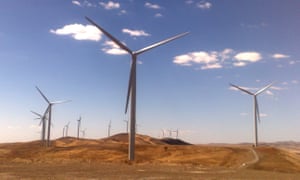Extract from The Guardian
Renewable energy
Clean Energy Australia snapshot shows investment in large-scale projects has doubled to $20bn
Despite Canberra remaining locked in ongoing partisan war about emissions reductions, and Malcolm Turnbull losing the prime ministership after a conflagration about energy policy, 2018 was a boom year for renewable energy, according to the latest Clean Energy Australia report.
The new assessment, to be released Thursday, finds the amount of renewable energy capacity committed in Australia during 2018 increased 260% on 2017, with 14.8 GW underway in 2018 compared to 5.6 GW in 2017.
The upbeat industry report card comes as the energy minister Angus Taylor will tell parliament on Thursday that Australia’s 2020 large scale renewable energy target of 33,000 GWh will be met ahead of time.
Taylor will report that approximately 5.2 gigawatts of new renewable
capacity was added during 2018, and also cite forecasts from the Clean Energy Regulator predicting an increase to at least 6.5 gigawatts in 2019, with the trend likely to persist in 2020 and 2021.The new assessment, to be released Thursday, finds the amount of renewable energy capacity committed in Australia during 2018 increased 260% on 2017, with 14.8 GW underway in 2018 compared to 5.6 GW in 2017.
The upbeat industry report card comes as the energy minister Angus Taylor will tell parliament on Thursday that Australia’s 2020 large scale renewable energy target of 33,000 GWh will be met ahead of time.
Guardian Australia understands the energy minister will note that large-scale generation certificate prices have crashed from around $85 a year ago to $34 today, reducing subsidies by 60%, which has a positive impact on consumer power bills.
It says the top three postcodes with the highest uptake of rooftop solar are Bundaberg, Hervey Bay and Toowoomba – in National party heartland.
The chief executive of the Clean Energy Council, Kane Thornton, noted while the industry was going gangbusters, “unfortunately, the politics around energy reached another new low in 2018, with the federal government opting to tear itself apart rather than implement its own national energy guarantee”.
Thornton said while the coming federal election would create another pivotal year for clean energy in Australia, “we have thankfully reached a point where politics isn’t as existential to the industry as it once was”.
The upbeat trends in renewables comes as the Australian Energy Market Commission will report on Thursday that Australia’s energy grid is meeting consumers’ needs, but also note the energy market operator is intervening more frequently to preserve the stability of the network.
The AEMC says the switch in the mix in favour of cleaner and greener technologies is a structural change that is putting pressure on power system security and reliability. The new report notes system security–related costs are a relatively small proportion of a customer’s total bill, “however, these costs are increasing, with potential flow-through effects to consumer bills in coming years”.
While the AEMC is concerned about a looming crunch point, with the upcoming retirement of thermal coal power stations across the eastern seaboard and deteriorating system strength, the energy market operator has already declared the future of power generation in Australia will be renewables with storage, and gas, with those technologies able to replace the power currently supplied by coal generators at least cost.
In its integrated system plan released last year, the Australian Energy Market Operator plan noted that 30% of Australia’s coal generators will approach the end of their technical life over the next two decades. It said it was important to avoid premature departures if the looming transition in the national energy market was to be orderly.
But Aemo said the lowest-cost replacement options for retiring coal plants “will be a portfolio of resources, including solar (28GW), wind (10.5 GW) and storage (17 GW and 90 GWh), complemented by 500 MW of flexible gas plant and transmission investment”.
The energy market operator concluded that mix of generation can produce 90 terawatt hours of energy per annum, “more than offsetting the energy lost from retiring coal-fired generation”, also noting that transmission infrastructure would need to be reinforced to ensure the grid performs optimally after the shift.

No comments:
Post a Comment